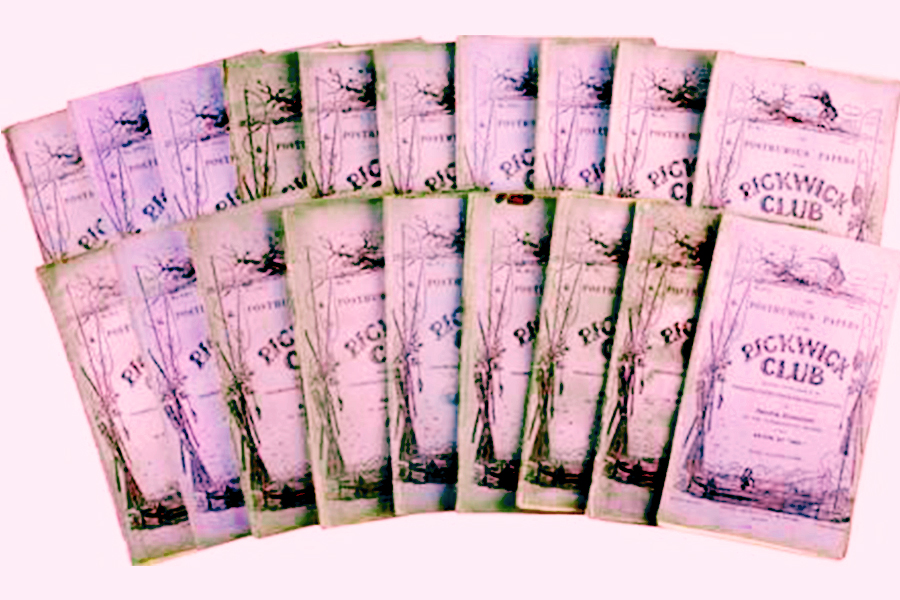Part two in Evan Wood’s quest to find out what’s up with serialized fiction.
by Evan Wood
Even though serialized fiction has potential with contemporary readers, the format has yet to show signs of economic viability. The Wall Street Journal pronounced “The Return of the Serial Novel” last year, but how can we tell if it’s really come back?
The trend to look for is how major mainstream authors are publishing their work. In the nineteenth century, which was the golden age for serial printing in America, major authors released their work in serial first, then as a standalone volume when the serial was complete.
Today, this isn’t the case; mainstream authors are not rushing to be serialized. For the most successful writers, there is very little incentive to defect from the current system where authors sign contracts with publishers, agree on advances and royalties, and publish their books in full-format.
Even though it didn’t see the twenty-first century rebirth some had predicted, serialization is being used by smaller, newer companies in innovative ways.
Rooster, founded by Yael Goldstein Love and Jen Lee, has published an original novel by Rachel Kadish called I Was Here, with a unique approach to serialization. Rooster delivers small chunks of novels daily, which can theoretically be read in about 15 minutes total. Readers are meant to occupy the intermittent free time in their otherwise busy day with these bits of fiction.
Then there’s JukePop, another digital serialization platform, which uses a system that’s basically the reverse of the nineteenth century model. JukePop founder and CEO Jerry Fan describes his company as an “incubator,” a place for developing authors to market-test their work. Using JukePop, authors are able to track reader retention as they publish their stories chapter-by-chapter. Rather than trying to workshop an entire novel at once, a writer can see exactly where the story lost the reader’s interest or favor.
Serializing on JukePop is for the aspiring writer, rather than the established one. It isn’t going to cover rent, but putting your work on JukePop can lead in promising directions. When an author’s story gets enough positive votes to be in the top 30 stories for the month, the author gets a cash reward. Authors can also invite readers to donate if they like the story. According to Fan, the biggest donation an author has received was a thousand dollars.
Black Hill Press, a small publisher that focuses on novellas, recently collaborated with JukePop on their Summer Writing Project, in which writers serialize their novellas using JukePop’s platform. In the end, three participating authors—Shaunn Grulkowski, Scott Alumbaugh, and J.T. Robertson—got publishing contracts. The novellas written by all three authors were released on December 2.
“We don’t like the idea of a traditional submission process,” says Kevin Staniec, co-founder of Black Hill Press. “We feel like it’s very disconnected for someone to just submit a manuscript and a cover letter.” According to Staniec, working with JukePop to choose new works to publish allowed for an open, community dialogue. Using JukePop’s serial format also allowed everyone to see which stories were retaining reader attention.
Black Hill is not Simon & Schuster, but it does say something that JukePop has proven itself a viable and alluring way for its writers to break into the industry. And at the very least, writers who serialize on JukePop are having their work read and market-tested by a community with an active interest in reading. In fact, bigger publishers probably should be keeping an eye on JukePop, especially as the marketplace continues to change.
On his blog Stratechery—which covers, among other things, tech and media industry trends—analyst Ben Thompson claims that as the publishing industry evolves, modern, successful writers will “do what they do best and accrue outsized value relative to publishers that are rapidly shifting from platform to obstacle.” In Thompson’s estimation, traditional publishers are becoming speed bumps for writers. The market may not currently reflect this estimation, but in five to ten years, that could change—especially as innovative companies with niche audiences continue to appear and grow.
Thompson references the “smiling curve” graph, and draws one of his own, placing writers on the left, aggregators and sharing platforms like Facebook and Google News on the right, with traditional publishers in the middle, the lowest apex of the curve.
In Thompson’s estimation, mainstream writers, if they availed themselves to self-publishing outlets, would have unprecedented agency that will only continue to grow as market access continues to be concentrated on social sharing platforms. Meanwhile, niche publishers and publications can take advantage of a similar power dynamic by cultivating relationships directly with their readers, which is precisely why companies like Black Hill Press care so much about community engagement.
The existence of companies like JukePop, Black Hill Press and Rooster is consistent with Thompson’s argument about traditional publishers. All three startups could be described as “focused publications” per his model, and if they can prove their worth, they will be a profitable part of publishing in the digital era.
Rooster is currently publishing previously-released work, but hopes to deliver more and more original fiction. According to Fan, JukePop is still trying to identify its primary source of revenue. Both platforms have proved in different ways that serializing still has relevance when applied correctly to contemporary needs.
It’s a safe bet that the serial novel is not going to return to its nineteenth century dominance in publishing. But that doesn’t mean you should write it off altogether—look for it to keep appearing here and there in new and interesting forms.
[hr style=”striped”]




